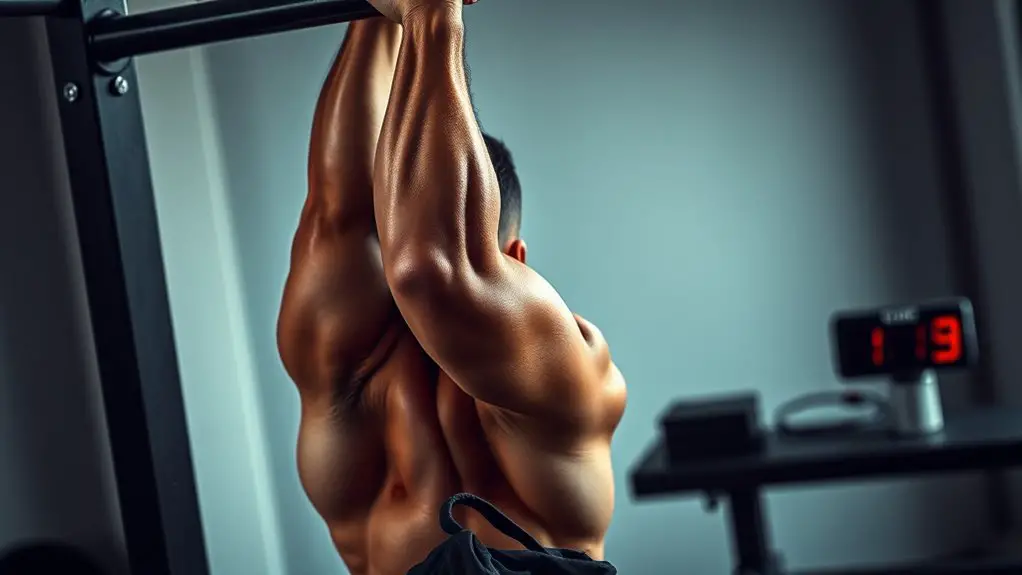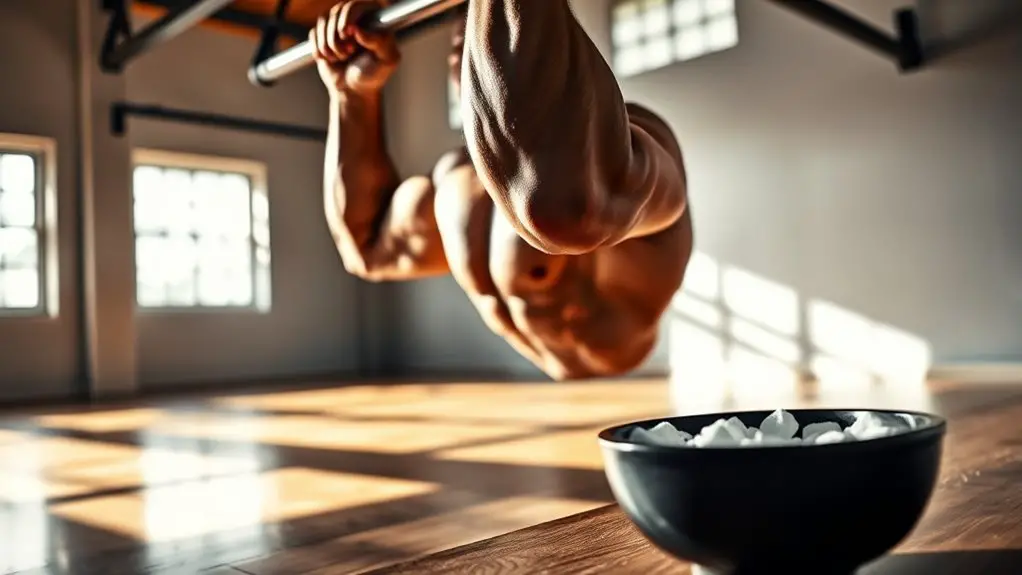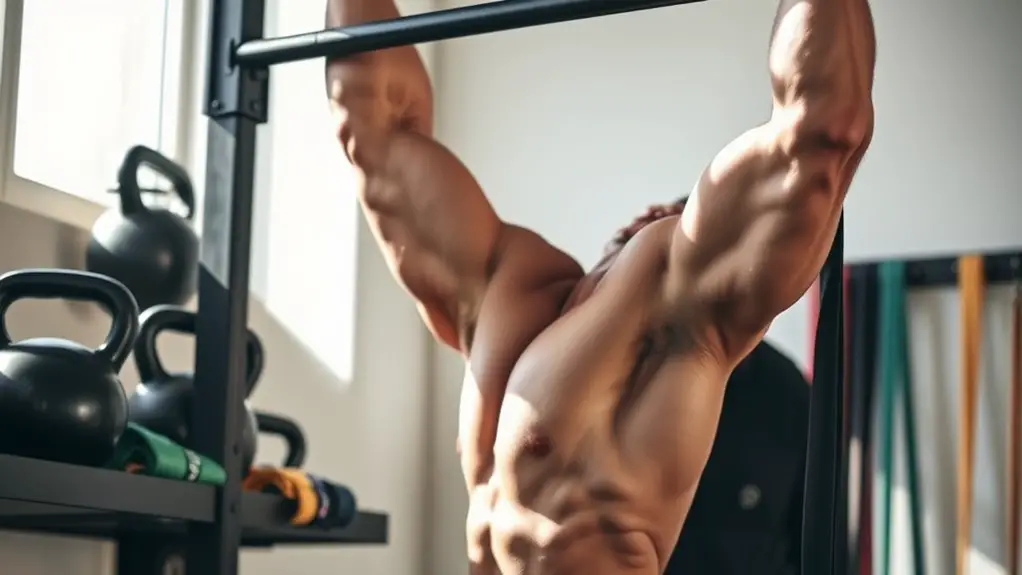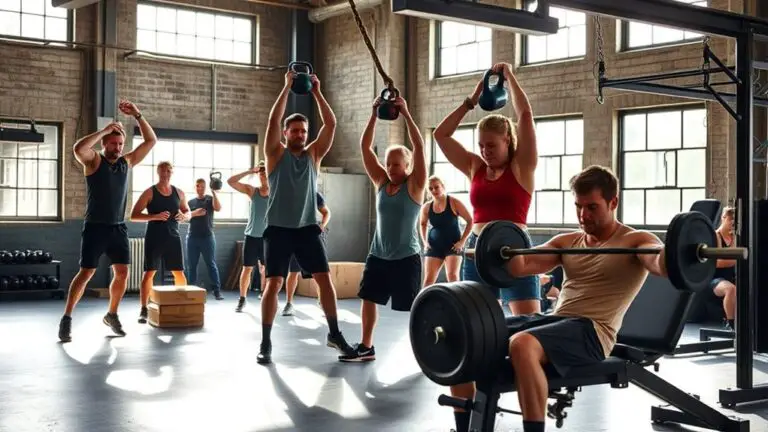How to Train for a One-Arm Pull-Up

To train for a one-arm pull-up, start by mastering standard pull-ups to build your upper body strength. Assess your current level and progress to assisted one-arm variations using resistance bands for support. Incorporate strength training exercises and focus on improving core and grip strength with dead hangs and planks. Set achievable goals and track your progress for motivation. With dedication and the right approach, you’ll get closer to that one-arm pull-up. Discover more effective strategies along the way!
Understanding the One-Arm Pull-Up

The one-arm pull-up is a remarkable feat of strength and control that showcases your upper body power. To achieve this, you need to understand the unique one-arm mechanics involved. Unlike a standard pull-up, using one arm requires precise body positioning and balance, allowing for ideal muscle recruitment.
Your core plays an essential role in stabilizing your body throughout the movement, while your lats and biceps need to work in harmony with your shoulder muscles. Mastering the one-arm pull-up isn’t just about raw strength; it’s about how effectively you can engage these muscles while minimizing unnecessary strain.
Start by building a solid foundation with regular pull-ups and gradually incorporate exercises that emphasize unilateral strength, like one-arm rows. Focus on form and control, and remember, consistency is key. Stay motivated, and you’ll make impressive progress toward conquering the one-arm pull-up!
Assessing Your Current Strength Level
Before you can tackle the one-arm pull-up, it’s important to evaluate where you currently stand regarding strength. A thorough strength assessment will provide insight into your current abilities and help you set realistic goals. Start by performing standard pull-ups; this will gauge your baseline strength. If you can do ten or more, you’re on the right track.
Next, try assisted one-arm pull-ups using resistance bands or a pull-up machine. This will help you identify how much support you need to build strength in that single arm.
Take note of your weaknesses—whether it’s grip strength, endurance, or overall muscle control. Understanding these areas will guide your training focus.
Building a Strong Foundation With Basic Pull-Ups

To achieve a one-arm pull-up, you first need to master standard pull-ups. This foundation not only builds your upper body strength but also introduces you to grip variations that can enhance your training. Don’t forget, a strong core is essential; it supports your entire movement and helps you progress effectively.
Mastering Standard Pull-Ups
Master standard pull-ups to build the strength necessary for advanced moves like the one-arm pull-up. Start by focusing on proper pull-up techniques; engage your core and maintain a controlled motion throughout. Aim for full range of motion—chin above the bar and a steady descent. As you progress, increase your repetitions and sets to enhance your strength progression.
Incorporate different training methods, like negative pull-ups and assisted variations, to prevent plateaus and improve endurance. Consistency is key, so set a schedule and stick to it. Track your progress to stay motivated and celebrate your milestones. With dedication and practice, you’ll lay a solid foundation for those impressive one-arm pull-ups. Keep pushing your limits!
Grip Variations Explained
While building a strong foundation with pull-ups, exploring different grip variations can greatly enhance your strength and technique. Each grip type—whether it’s overhand, underhand, or neutral—targets your muscles differently, promoting balanced development. The overhand grip focuses on your lats and upper back, while the underhand grip emphasizes your biceps. Don’t forget the neutral grip, which is great for shoulder stability and comfort.
Incorporating these variations into your routine can improve your grip strength, essential for mastering one-arm pull-ups. Start with basic pull-ups using these grips and gradually progress in intensity. Remember, consistency is key. Keep challenging yourself, and soon, you’ll notice significant gains in your overall pulling power and control. So, grab that bar and get started!
Building Core Strength
As you work toward mastering the one-arm pull-up, building core strength is essential for maintaining stability and control during the movement. A strong core provides the foundation you need to execute dynamic movements effectively. Start with basic pull-ups to engage your core; focus on keeping your body straight and avoiding swinging. Incorporate exercises like planks, hanging leg raises, and hollow body holds to enhance core stability. These will not only strengthen your midsection but also improve your overall performance. Remember, quality over quantity matters—maintain proper form to reap the full benefits. As you progress, you’ll find that a strong core greatly contributes to your ability to perform a one-arm pull-up with confidence and efficiency. Keep pushing yourself!
Progressing to Assisted One-Arm Pull-Up Variations

Now that you’ve built a solid foundation, it’s time to explore assisted one-arm pull-up variations. Using resistance bands, towel grips, or focusing on eccentric training can help you gradually build the strength you need. Let’s break down these techniques to guarantee you’re on the right path to mastering that one-arm pull-up!
Resistance Band Assistance
To successfully progress toward an assisted one-arm pull-up, incorporating resistance band assistance can be a game-changer. Start by choosing the right band selection based on your current strength and skill level. Thicker bands provide more support, while thinner bands challenge you more. Experiment with different resistance levels to find the ideal balance that allows you to perform the movement with good form.
Attach the band to a pull-up bar and place one foot or knee in it, helping you lift your body. Focus on engaging your muscles as you pull up, gradually reducing reliance on the band. As you gain strength, consider using bands with lower resistance or even moving to unassisted variations. Stay consistent, and you’ll see progress!
Towel or Rope Grip
After mastering resistance band assistance, it’s time to incorporate towel or rope grips into your training. These towel techniques and rope variations challenge your grip strength and activate different muscle fibers, essential for achieving a one-arm pull-up. Start by hanging a towel or rope over your pull-up bar, gripping it firmly with one hand while keeping the other hand for support. Gradually shift more weight to the working arm as you gain confidence. You can also practice alternating grips, switching hands to build balanced strength. Incorporating these variations not only enhances your grip but also prepares your body for the unique demands of a one-arm pull-up. Stay consistent, and you’ll see progress!
Eccentric One-Arm Training
Eccentric one-arm training is a powerful way to build the strength necessary for mastering a one-arm pull-up. This method focuses on the lowering phase of the pull-up, where you can control your descent while engaging your muscles effectively. Start by using both arms to pull up, then slowly lower yourself with one arm. This eccentric training helps create significant strength adaptations, allowing your body to adjust to the demands of a one-arm pull-up.
As you progress, you can gradually reduce assistance by using a band or lowering your body weight. Remember, consistency is key. Perform these exercises regularly to maximize strength gains, and soon you’ll find yourself closer to achieving that elusive one-arm pull-up. Stay focused and keep pushing!
Incorporating Specific Strength Training Exercises

While mastering the one-arm pull-up may seem challenging, incorporating specific strength training exercises can greatly accelerate your progress. Start by focusing on unilateral exercises, like single-arm rows and dumbbell shoulder presses. These movements help build the strength and stability required for a one-arm pull-up.
Next, implement exercise progression by gradually increasing the weight or resistance as you get stronger. You can also include assisted one-arm pull-ups using bands or a partner to support you while you develop your strength.
Don’t forget to include isometric holds at the top position of the pull-up; they’ll enhance your muscle endurance. Aim for three to four strength training sessions per week, ensuring you give your muscles time to recover between workouts. Stay consistent, and you’ll see improvement in your strength and technique, getting you closer to that impressive one-arm pull-up.
Developing Core and Grip Strength
To successfully execute a one-arm pull-up, developing core and grip strength is essential. Your core stabilizes your body during the movement, while your grip holds you to the bar. Start by incorporating core exercises like planks, hanging leg raises, and Russian twists into your routine. These will enhance your abdominal strength and overall stability.
For grip techniques, practice dead hangs and towel hangs. These not only improve grip strength but also build endurance in your forearms. You might also try using a thicker bar or adding weights to your hangs to further challenge your grip.
Consistency is key—aim to integrate these exercises into your weekly workouts. As you progress, you’ll notice improvements in both your core stability and grip strength, making your journey to that one-arm pull-up much more achievable. Stay committed, and you’ll get there!
Tips for Consistency and Motivation

Building core and grip strength is just the beginning of your journey to a one-arm pull-up; staying consistent and motivated is what will ultimately get you there. Start by setting clear, achievable goals. Break your main goal into smaller milestones, so you can celebrate progress along the way. This’ll keep you motivated and focused on the next step.
Incorporate progress tracking into your routine. Keep a training journal or use an app to log your workouts and improvements. Seeing how far you’ve come can be incredibly motivating, especially on tough days.
Mix up your training to avoid burnout; try different exercises or vary your routine. Finally, find a workout buddy or join a community. Sharing your journey with others can provide support and encouragement, making it easier to stay consistent. Remember, persistence is key—every small step brings you closer to that one-arm pull-up! Additionally, it’s important to acknowledge the need for rest days to avoid burnout and maintain long-term motivation.
Frequently Asked Questions
How Long Does It Take to Achieve a One-Arm Pull-Up?
It typically takes about six months to a year to achieve a one-arm pull-up, but this varies widely. One interesting statistic shows that only about 1% of gym-goers can perform this feat, highlighting the challenge it represents. Your progress timeline will depend on individual factors like your current strength, training consistency, and body weight. Stay motivated and focused, and remember that every small improvement brings you closer to that impressive goal!
Can Beginners Attempt One-Arm Pull-Ups?
Absolutely, beginners can attempt one-arm pull-ups, but it’s essential to focus on strength progression. Start with beginner techniques, like assisted or negative pull-ups, to build your back and arm strength. Incorporating exercises like single-arm rows and grip training will help, too. Remember, it takes time, so be patient and consistent with your workouts. Celebrate small victories, as they’ll motivate you to reach your one-arm pull-up goal! Keep pushing yourself!
What Common Mistakes Should I Avoid?
When you’re aiming for impressive feats, it’s crucial to sidestep a few common pitfalls. First, don’t underestimate the importance of grip strength; it’s your foundation. Next, watch out for muscle imbalances that can hinder your progress. Neglecting supportive exercises can lead to frustration down the line. Finally, remember to prioritize form over quantity; it’s not just about how many you can do, but how well you can do them. Keep pushing forward!
Are There Specific Diets to Support Training?
When it comes to supporting your training, focusing on your diet is essential. You should prioritize protein intake to help with muscle recovery and growth. Aim for high-quality sources like lean meats, fish, and legumes. Meal timing also plays a role; try to consume protein-rich meals or snacks before and after workouts to fuel your body effectively. Staying hydrated and incorporating healthy carbs will further enhance your performance and recovery. You’ve got this!
Should I Focus on One Arm or Both During Training?
When training, you should focus on both arms to avoid muscle imbalances. While progressive overload is key to building strength, training one arm exclusively could lead to uneven development and potential injuries. Start with balanced exercises, then gradually incorporate one-arm variations as you progress. This way, you’ll build overall strength while still working toward your goal. Keep challenging yourself, and remember to listen to your body to guarantee sustainable growth.





